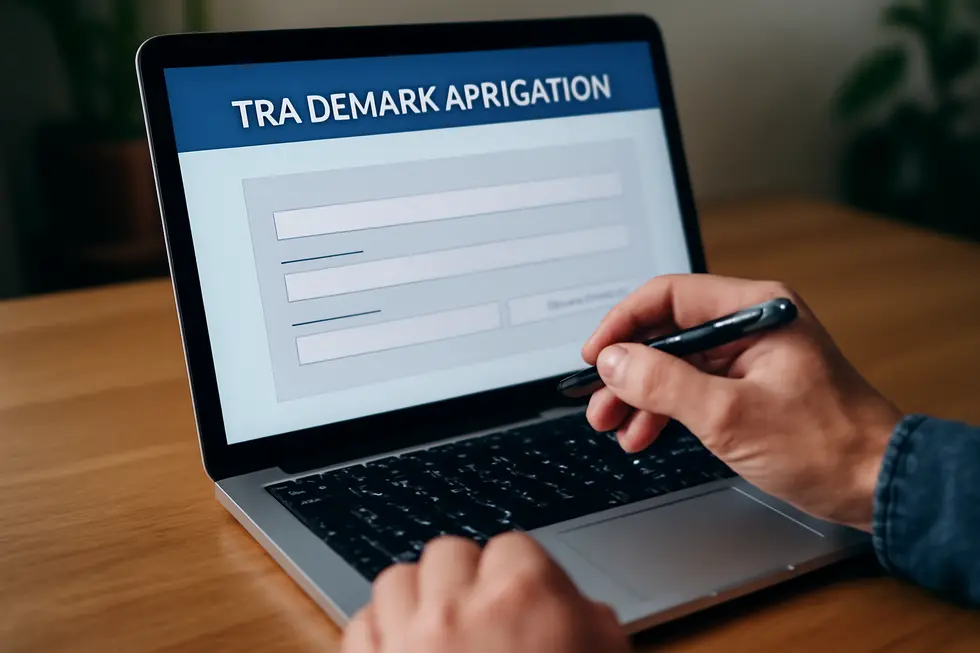Introduction
Understanding the difference between copyright and trademark protection is crucial for any business owner seeking to secure their brand name effectively. While copyright protects creative works such as books, music, and artwork, it does not extend to brand names, logos, or slogans. Instead, trademark registration provides the legal framework to uniquely identify and protect your brand identity in the marketplace. This article guides you through the misconception of “copyrighting a brand name” and demonstrates the importance of trademark law. It breaks down the trademark process into actionable steps—from conducting a trademark search to maintaining and renewing your registration—empowering you to safeguard your brand with confidence. Each chapter builds upon the previous one, clarifying how to navigate this complex process to ensure your brand stands protected legally and commercially.
Tables of Contents
Chapter 1: How to Copyright a Brand Name: Understanding the Limits of Copyright Protection
- Why Brand Names Fall Outside Copyright and Require Trademark Protection Instead
- Why Trademarks Instead of Copyrights Are Key to Protecting Your Brand Name
Chapter 2: How to Copyright a Brand Name: Step 1 – Mastering Trademark Searches for Unique Brand Identity
- How to Copyright a Brand Name: Step 1 – Conducting a Comprehensive Trademark Search Using USPTO’s TESS
- Conducting a Trademark Search: Ensuring Your Brand Name’s Uniqueness to Prevent Legal Conflicts and Maximize Market Impact
Chapter 3: How to Copyright a Brand Name: Step 2 – Selecting the Correct Trademark Class for Effective Protection
- Navigating Trademark Classes: Why Choosing the Right Class Secures Your Brand Name
- Mastering Trademark Classes to Secure Comprehensive Brand Name Protection
Chapter 4: How to Copyright a Brand Name: Step 3 – Filing Your Trademark Application
- Mastering the Trademark Application: Preparing, Filing, and Tracking Your Brand Name Registration
- Navigating Trademark Examination and Ensuring Your Brand Name’s Legal Approval
Chapter 5: How to Copyright a Brand Name: Navigating the Trademark Process and Registration
- Ensuring Your Brand’s Protection: Conducting a Thorough Trademark Search Before Registration
- Mastering the Trademark Journey: Filing, Examining, and Sustaining Brand Name Protection
Chapter 6: How to Copyright a Brand Name: Maintaining and Renewing Your Trademark Rights
- Navigating the Trademark Registration Journey: Securing and Sustaining Your Brand Name’s Legal Shield
- Essential Practices to Sustain and Renew Your Trademark for Long-Term Brand Security
Chapter 1: How to Copyright a Brand Name: Understanding the Limits of Copyright Protection

1. Why Brand Names Fall Outside Copyright and Require Trademark Protection Instead
Understanding Why Copyright Does Not Protect Brand Names
Copyright law safeguards original creative works that are fixed in a tangible form, such as novels, music recordings, or paintings. However, this protection explicitly excludes names, titles, slogans, or short phrases. Brand names fall into this excluded category because they function as commercial identifiers rather than creative expressions. Essentially, copyright protects the expression of ideas, not the ideas or labels themselves.
This distinction is vital since brand names serve to distinguish the source of goods or services in the marketplace, rather than convey artistic or literary content. Because of this, trademark law is the proper legal mechanism to protect brand names. Trademarks cover words, logos, or symbols that uniquely identify a business, preventing competitors from using confusingly similar marks that could mislead consumers.
Registering a trademark with a government authority, like the USPTO, grants exclusive rights to use your brand name within the approved goods or services categories. This registration strengthens legal protections by allowing owners to enforce their rights against infringement, which copyright cannot do for brand names. Moreover, maintaining a trademark requires active use and vigilance to defend it.
For entrepreneurs and businesses aiming to protect their brand identity, understanding this clear boundary between copyright and trademark protections avoids costly legal missteps. Trademark registration is the crucial step to legally secure a brand name’s commercial value.
Learn more about protecting your brand with trademarks at trademark protection for business name and logo.
For further official details on the scope of copyright versus trademark, see Kaway Law’s explanation.
2. Why Trademarks Instead of Copyrights Are Key to Protecting Your Brand Name
Copyright law and trademark law serve distinct purposes, especially when it comes to protecting brand names. Copyright protects original creative works fixed in tangible form, such as books, music, artwork, or software code. It does not extend to short phrases, names, or titles because these elements lack the requisite originality and creativity. In contrast, a brand name functions as an identifier that distinguishes your goods or services from others, a role that copyright cannot fulfill.
Trademark law is specifically designed to protect such identifying elements of a business. It grants rights to names, logos, slogans, and other marks that consumers associate with a particular source. Trademark protection arises either from actual commercial use or through formal registration with the United States Patent and Trademark Office (USPTO), which provides nationwide legal advantages such as the exclusive right to use the mark and the ability to enforce those rights in court.
Unlike copyright, trademarks guard against confusingly similar uses by competitors within the same industry, preserving brand reputation and customer trust. Even though unregistered trademarks (common law rights) provide some protection, these are geographically limited and less robust than federally registered marks.
Because copyright does not guard brand names, businesses must rely on trademark registration to secure legal protection. This involves verifying the uniqueness of the name, selecting the correct trademark class, filing an application, and maintaining the registration over time. Displaying the ™ symbol asserts your claim on a mark, while the ® symbol signals federal registration.
For those looking to protect their brand identity properly, focusing on trademark registration is essential rather than seeking copyright. More detailed guidance on securing exclusive rights through trademarks can be found at trademark protection for business name and logo.
For a thorough explanation of the distinctions and protections, see https://www.gandhiselimlaw.com/trademark-vs-copyright-how-to-legally-protect-your-intellectual-property/
Chapter 2: How to Copyright a Brand Name: Step 1 – Mastering Trademark Searches for Unique Brand Identity

1. How to Copyright a Brand Name: Step 1 – Conducting a Comprehensive Trademark Search Using USPTO’s TESS
Protecting a brand name begins with ensuring its uniqueness, which is achieved through a thorough trademark search using the United States Patent and Trademark Office’s (USPTO) Trademark Electronic Search System (TESS). This critical first step helps you avoid infringing on existing trademarks and increases the likelihood that your registration will be approved.
To start, visit the USPTO website and navigate to TESS, where several search options are available. The most effective choice is the Word and/or Design Mark Search (Free Form), as it provides broad flexibility to examine exact matches and similar marks. Input your desired brand name to reveal existing registrations or applications that could conflict with your choice.
Carefully analyzing the search results allows you to identify whether your brand name is sufficiently distinct or if adjustments are needed to avoid legal disputes. If you discover conflicting marks, consider altering your name or seek advice from a trademark attorney to navigate potential complexities.
Understanding that copyright law does not protect brand names underscores why this trademark search is indispensable. It directs your efforts toward the proper legal framework, as trademarks specifically safeguard the identifiers that distinguish your goods or services.
Performing this search independently provides valuable insight and streamlines subsequent trademark application steps. Once uniqueness is confirmed through TESS, you can confidently proceed with filing a trademark application to secure exclusive rights to your brand name.
For a detailed guide on navigating USPTO’s trademark search tool and its search options, see the official USPTO Trademark Electronic Search System (TESS).
Learn more about trademark protection for business names in this comprehensive resource on trademark protection business name logo.
2. Conducting a Trademark Search: Ensuring Your Brand Name’s Uniqueness to Prevent Legal Conflicts and Maximize Market Impact
The critical first step in safeguarding your brand name is conducting a comprehensive trademark search to confirm its uniqueness. Since copyright law does not extend to brand names, this search is essential to avoid stumbling into existing trademarks that could block your application or spark legal disputes.
This process involves examining databases such as the United States Patent and Trademark Office’s (USPTO) Trademark Electronic Search System (TESS), where you can investigate both word and design marks. It is vital to explore all possible variations and spellings of your proposed name, as trademarks are strictly evaluated based on exact wording, and even slight similarities may cause confusion. Additionally, considering searches in state trademark databases, common law trademarks, and international systems strengthens your search if you intend to grow your business beyond local borders.
Equally important is understanding the correct trademark class for your goods or services. Since trademarks are assigned protection by class, identifying the appropriate category prevents conflicts within your industry segment and clarifies your rights. Because this step can be complex, consulting trademark attorneys or experienced professionals can help interpret search results accurately, reducing the risk of costly rebranding or legal challenges later.
A detailed trademark search ultimately establishes a solid foundation for your brand’s legal protection and distinctiveness, allowing you to confidently move forward with the trademark registration process. For official tools and additional guidance, visiting the USPTO trademark search page is highly recommended.
For further insight into trademark protection strategies, see our article on trademark protection for business name and logo.
Chapter 3: How to Copyright a Brand Name: Step 2 – Selecting the Correct Trademark Class for Effective Protection

1. Navigating Trademark Classes: Why Choosing the Right Class Secures Your Brand Name
When protecting a brand name through trademark registration, accurately selecting the correct trademark class is crucial because trademark rights apply specifically to the goods or services identified within those classes. The international classification system, known as the Nice Classification, organizes products and services into 45 classes—34 for goods and 11 for services—to streamline registration and enforcement globally. For example, a clothing brand requires registration in Class 25, which covers clothing, footwear, and headgear. If the brand also deals in fabrics, protection under Class 24 is necessary since it covers textiles and fabric materials. Similarly, a restaurant would be registered under a service class, such as Class 43 for food and restaurant services. Misclassifying or failing to register in all relevant classes can leave parts of a brand vulnerable, exposing it to infringement risks or denying comprehensive protection.
The importance of correctly classifying trademarks also extends to managing costs since fees are charged per class, encouraging careful consideration to balance coverage with expense. Proper class selection can prevent conflicts by delineating the scope of protection. This specificity guards against infringement claims from unrelated sectors and clarifies rights for third parties. Businesses spanning multiple product lines should thoughtfully assess which classes encompass their offerings to secure full trademark protection. These categories serve not just administrative purposes but establish the legal framework that defines your trademark’s boundaries in commerce.
For detailed guidance, reviewing the trademark class system can help ensure your brand’s classification aligns with your market presence. Additionally, the USPTO’s official resources on classification offer authoritative direction on choosing the correct trademark classes. Understanding these distinctions lays a foundation for effective brand name protection through trademark registration.
(Source: Trademark Registration Process and Fees)
2. Mastering Trademark Classes to Secure Comprehensive Brand Name Protection
Protecting your brand name through trademark registration hinges critically on selecting the appropriate trademark class or classes. Trademark protection operates within a system of specific classes that categorize goods and services—45 in total, with 34 for goods and 11 for services. Choosing the correct class aligns your brand with the precise market segment it serves, ensuring exclusive rights within that area. For example, dyes used in industrial applications fall under Class 2, whereas cosmetic dyes belong in Class 3. Overlapping or misclassified categories risk application denial or insufficient legal protection.
If your brand spans multiple industries or product lines, registering your trademark across several relevant classes strengthens your protection and anticipates future growth. For instance, a company offering both protective paints and construction services may register under Class 2 and Class 37 respectively, securing comprehensive coverage. This foresight can help avoid costly reapplications if your business expands.
Tools like trademark classification finders simplify identifying the most fitting classes by matching your goods or services to the correct categories. In complex cases, consulting a trademark attorney is highly advisable to navigate subtleties and optimize your registration strategy. Be mindful that each selected class entails an additional fee, so balancing cost against the breadth of protection is essential.
A diligent search across all prospective classes and name variants also mitigates the risk of disputes with conflicting trademarks. Ensuring your application’s accuracy and strategic scope elevates your brand’s legal security and market value.
For a detailed guide on trademark classes, see UpCounsel’s article on Class 2 trademarks and international trademark classes. This resource elucidates classification significance and common pitfalls to avoid.
For related insights on trademark protections, visit trademark2go.com.
Chapter 4: How to Copyright a Brand Name: Step 3 – Filing Your Trademark Application

1. Mastering the Trademark Application: Preparing, Filing, and Tracking Your Brand Name Registration
Filing your trademark application is a critical step in securing legal protection for your brand name. This process begins with gathering all necessary details. You’ll need a clear trademark description, classification of the associated goods or services, complete applicant information, and any logo files if your brand includes a design element. Selecting the correct classification is crucial since trademarks are protected within specific categories tied to your business activities.
Next, you must choose the appropriate trademark office depending on your jurisdiction—for example, the USPTO in the United States. Modern trademark offices provide online filing systems, like the USPTO’s Trademark Electronic Application System (TEAS), allowing applicants to submit applications electronically. Electronic filing ensures a faster, more cost-effective procedure with the convenience of monitoring the application status in real time.
Accurate completion of the application form is vital to prevent delays or rejections. You will enter your trademark details, specify whether the mark is in use or intended for future use, and upload any supporting specimens. At submission, the required filing fees must be paid to initiate the examination process formally. If an attorney is involved, you may need to provide authorization forms permitting them to file on your behalf.
Once submitted, always keep confirmation receipts and track your application’s progress closely to respond promptly to any office actions or requests. This filing step sets the stage for the trademark office’s review, which may span over a year, depending on jurisdictional processing times.
For detailed procedural guidance and official resources, visit the Hostinger tutorial on how to trademark a business name. For more insights on the legal protection of business identifiers beyond copyright, explore our comprehensive article on trademark protection for business names and logos.
2. Navigating Trademark Examination and Ensuring Your Brand Name’s Legal Approval
After you file your trademark application, it undergoes a meticulous examination by the trademark office to verify compliance with legal standards. This process ensures your brand name is distinctive, properly classified according to your goods or services, and not confusingly similar to an existing trademark. If the examining attorney identifies any issues, they will issue an office action outlining objections or requesting additional information. Responding promptly and precisely to these office actions is crucial, typically within six months, to avoid abandonment of your application.
Once all objections are resolved, your application moves to the publication stage. Here, your brand name is published in an official gazette, offering a public opposition window—usually lasting 30 to 60 days—during which third parties can challenge your trademark registration if they believe it infringes on their rights. If no opposition is filed or if challenges are settled in your favor, your trademark proceeds to registration, and you will receive a certificate validating your exclusive rights.
Following registration, your responsibility shifts to monitoring and enforcing your trademark rights. Vigilantly watching for unauthorized uses and addressing potential infringements, often beginning with cease-and-desist notices, helps maintain your brand’s protection. The overall timeline from filing to registration generally spans 12 to 18 months, and submitting your application electronically enhances efficiency while enabling easy status tracking.
This critical examination and follow-up phase is fundamental to securing your brand name’s legal recognition. For further guidance on protecting your business identity through trademarks, visit trademark protection for business names and logos.
Additional official resources and timeline details can be found at Trademark Registration Guide.
Chapter 5: How to Copyright a Brand Name: Navigating the Trademark Process and Registration

1. Ensuring Your Brand’s Protection: Conducting a Thorough Trademark Search Before Registration
Before registering a brand name as a trademark, conducting a thorough trademark search is crucial to avoid conflicts and application refusals. Begin by clearly defining the exact mark you want to protect—this includes the brand name itself, logos, slogans, and any variations or misspellings that could lead to confusion. A preliminary internet search through platforms like Google and social media helps identify obvious uses of similar names that may not be federally registered but could impact your brand.
The core of the search involves utilizing the United States Patent and Trademark Office’s (USPTO) Trademark Electronic Search System (TESS). This database reveals federally registered and pending trademarks identical or similar to your mark. Since TESS searches exact terms, it’s important to explore variant spellings and use the Trademark Design Search Manual for logos or design elements. Expanding the search to state trademark registries and international databases like the World Intellectual Property Organization’s Global Brand Database helps protect broader markets.
Understanding trademark classes is essential because protection is granted within specific goods or services categories. Your search must cover relevant classes to uncover possible conflicts. Additionally, consider common law trademarks—unregistered marks that may still hold legal rights based on use—by exploring business directories and domain names.
Given the complexity of trademark law, consulting experienced trademark attorneys ensures accurate risk assessment and helps navigate the filing process smoothly. Filing without this rigorous search can lead to costly delays or disputes.
Investing time here safeguards your brand’s uniqueness and strengthens your application for trademark registration. For more on protecting your brand identity, see this detailed guide on trademark protection for business name and logo.
2. Mastering the Trademark Journey: Filing, Examining, and Sustaining Brand Name Protection
Filing, examining, and maintaining your trademark are crucial phases to secure legal protection for your brand name. The journey begins with a thorough search to confirm your brand name’s uniqueness. Utilizing databases such as the USPTO’s Trademark Electronic Search System (TESS) helps prevent conflicts with existing trademarks. Once confirmed unique, precisely prepare your application by detailing the brand name and selecting appropriate classes from the Nice Classification system that match your goods or services. Filing is done online via the trademark office’s platform, with fees typically ranging from $250 to $350 per class. Keeping your application confirmation is essential for tracking.
Following submission, a trademark examiner reviews your application to verify compliance and absence of conflicts. During this phase, you may receive Office Actions requesting clarifications or objecting to registration. Responding promptly and accurately is vital to avoid application abandonment. This examination period can range from several months up to 18 months depending on jurisdiction and complexity.
If the application meets all requirements and no oppositions arise during publication, your brand name is officially registered. This grants exclusive legal rights to use and enforce your trademark within the covered classes. However, protection is not indefinite; maintenance involves filing renewal documents and declarations of continued use—typically every 5 to 10 years. Neglecting these requirements risks cancellation of your trademark rights.
Federal registration offers broader protections than state-level marks, making it advisable for nationwide brand security. Given the complexities, consulting a trademark attorney can greatly improve application accuracy and defense during examination.
For a detailed walkthrough of the trademark application and examination process, see this comprehensive guide on trademarking a business name.
Chapter 6: How to Copyright a Brand Name: Maintaining and Renewing Your Trademark Rights

1. Navigating the Trademark Registration Journey: Securing and Sustaining Your Brand Name’s Legal Shield
Protecting a brand name begins with understanding that copyright law does not extend to names; instead, trademark registration is the essential route. The trademark registration journey starts with a comprehensive search—utilizing tools like the USPTO’s Trademark Electronic Search System (TESS)—to ensure your brand name is distinct and free from conflicts. This step safeguards against costly legal disputes and application refusals. Once uniqueness is confirmed, preparing a detailed application is crucial. This includes specifying the trademark, selecting the correct class that aligns with your goods or services, and submitting evidence of the mark’s commercial use, like packaging or advertising samples.
After filing, the trademark office rigorously examines the application for compliance and potential conflicts. Often, applicants must respond promptly to office actions that request clarifications or amendments. If all concerns are resolved and no valid oppositions arise during the publication period, registration follows, granting exclusive rights to use the brand name within the approved categories.
However, registration is not permanent without upkeep. Trademark rights generally last ten years but require timely renewals and proof of continued commercial use to remain valid. Failure to maintain this can result in forfeiture of rights. Beyond maintaining registration, brand owners must actively monitor the marketplace for unauthorized use and enforce their trademark to prevent dilution or infringement.
Given the complexity of this process and ongoing obligations, many seek expert legal guidance to navigate registration efficiently and preserve the brand’s legal protections. For further detailed guidance on trademark application and management, official resources like the USPTO website offer comprehensive instruction.
For more insights on protecting your brand name, explore trademark protection for business name and logo and official guidelines at the USPTO site.
2. Essential Practices to Sustain and Renew Your Trademark for Long-Term Brand Security
Maintaining and renewing your trademark registration involves proactive, ongoing efforts that are just as critical as securing the trademark initially. The cornerstone of protecting your brand name lies in regularly monitoring the marketplace for unauthorized use. Vigilance prevents dilution of your mark’s distinctiveness and guards against infringers who might weaken your legal rights if left unchecked. Equally important is the timely submission of renewal applications and declarations demonstrating the trademark’s continued commercial use—such as the required maintenance filings under U.S. law (for example, the Section 8 declaration). Missing renewal deadlines or failing to provide proof of use can lead to cancellation of your registration, stripping your exclusive rights.
Effective enforcement measures should accompany maintenance efforts. When infringement occurs, prompt actions like cease-and-desist notices help preserve the strength of your trademark. For businesses managing multiple trademarks or global portfolios, leveraging professional services ensures that renewal deadlines and legal nuances in various jurisdictions are met seamlessly. For smaller portfolios, robust internal tracking systems can suffice.
Expanding your trademark portfolio by registering alternative spellings, abbreviations, or color variations further shields your brand identity from competitors and counterfeiters. Aligning these efforts with a consistent visual identity strengthens your brand recognition and legal protections.
Adhering to these essential strategies guarantees the sustained value and exclusivity of your brand name over time. For a comprehensive understanding of common trademark protections and how they interplay with copyright limitations, explore this resource on trademark protection for business names and logos.
For official trademark maintenance guidelines, refer to the United States Patent and Trademark Office’s resources on renewal and continuous use filings.
Final thoughts
Securing the protection of your brand name is fundamental for building and sustaining a successful business identity. While copyright protects creative expressions, it does not extend to brand names or titles, making trademark registration the essential route for legal protection. By understanding the limitations of copyright law, conducting a comprehensive trademark search, selecting the correct trademark class, meticulously filing your application, navigating the registration process, and maintaining your trademark rights through timely renewals, you establish exclusive rights to your brand’s distinct identity in commerce. Taking these deliberate steps fortifies your business against infringement, ensures legal exclusivity, and reinforces the long-term value of your brand in the marketplace.
Your IP is the foundation of your success – let’s protect it together before it’s too late. We can’t wait to help you turn your ideas into legally secured assets.
About us
undefined


